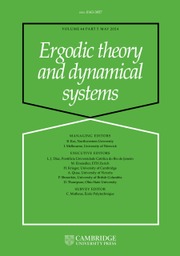Article contents
Asymptotic structure in substitution tiling spaces
Published online by Cambridge University Press: 27 September 2012
Abstract
Every sufficiently regular non-periodic space of tilings of  $\mathbb {R}^d$ has at least one pair of distinct tilings that are asymptotic under translation in all the directions of some open
$\mathbb {R}^d$ has at least one pair of distinct tilings that are asymptotic under translation in all the directions of some open  $(d-1)$-dimensional hemisphere. If the tiling space comes from a substitution, there is a way of defining a location on such tilings at which asymptoticity ‘starts’. This leads to the definition of the branch locus of the tiling space: this is a subspace of the tiling space, of dimension at most
$(d-1)$-dimensional hemisphere. If the tiling space comes from a substitution, there is a way of defining a location on such tilings at which asymptoticity ‘starts’. This leads to the definition of the branch locus of the tiling space: this is a subspace of the tiling space, of dimension at most  $d-1$, that summarizes the ‘asymptotic in at least a half-space’ behavior in the tiling space. We prove that if a
$d-1$, that summarizes the ‘asymptotic in at least a half-space’ behavior in the tiling space. We prove that if a  $d$-dimensional self-similar substitution tiling space has a pair of distinct tilings that are asymptotic in a set of directions that contains a closed
$d$-dimensional self-similar substitution tiling space has a pair of distinct tilings that are asymptotic in a set of directions that contains a closed  $(d-1)$-hemisphere in its interior, then the branch locus is a topological invariant of the tiling space. If the tiling space is a two-dimensional self-similar Pisot substitution tiling space, the branch locus has a description as an inverse limit of an expanding Markov map on a zero- or one-dimensional simplicial complex.
$(d-1)$-hemisphere in its interior, then the branch locus is a topological invariant of the tiling space. If the tiling space is a two-dimensional self-similar Pisot substitution tiling space, the branch locus has a description as an inverse limit of an expanding Markov map on a zero- or one-dimensional simplicial complex.
Information
- Type
- Research Article
- Information
- Copyright
- Copyright © 2012 Cambridge University Press
References
- 4
- Cited by

